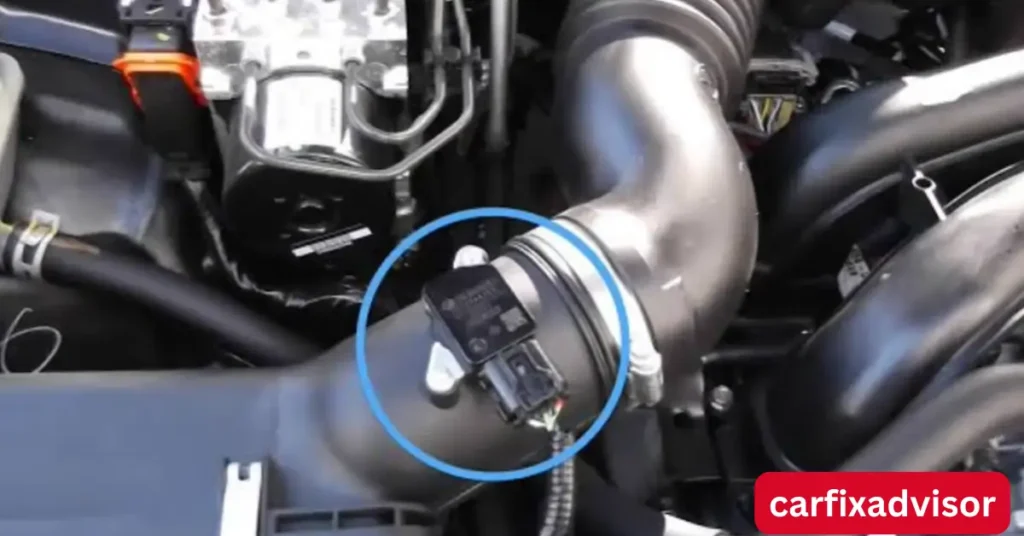A bad mass air flow sensor no check engine light can create a frustrating scenario for car owners. Normally, a faulty MAF sensor triggers the check engine light, alerting you to the problem. But when the sensor fails silently, it becomes much harder to diagnose the issue.
This article explains what happens when you have a bad mass air flow sensor no check engine light situation. We’ll cover symptoms to watch for, common causes, and how to test and fix the sensor even when your dashboard stays quiet.
What is a Mass Air Flow Sensor?
Understanding the MAF sensor is key to recognizing why a bad mass air flow sensor no check engine light can be so tricky.
Function: Measures the amount of air entering the engine to help the ECU adjust fuel injection.
Location: Positioned between the air filter and the throttle body in the intake system.
Role: Maintains the correct air-fuel ratio, essential for engine efficiency and emission control.
How the Mass Air Flow Sensor Works
The sensor contains a heated wire or film. As air flows past, it cools this element. The sensor measures the cooling effect, which indicates how much air enters the engine. If the sensor is dirty or failing, it sends wrong signals to the ECU, disrupting fuel delivery.
Symptoms of a Bad Mass Air Flow Sensor No Check Engine Light
You might not see a warning light, but your car could still show signs of a bad mass air flow sensor no check engine light:
Loss of power or hesitation when accelerating.
Rough or unstable engine idle causing vibration.
Engine stalling or sudden surges during driving.
Lower fuel economy and increased fuel consumption.
Difficulty starting the engine or prolonged cranking.
Ignoring these symptoms can lead to bigger problems, so it’s important to consider a bad mass air flow sensor no check engine light when these issues appear.
Common Causes of a Bad Mass Air Flow Sensor No Check Engine Light
Even without a check engine light, several factors can cause a bad mass air flow sensor no check engine light condition:
Dirty Air Filter
A clogged or dirty air filter restricts airflow. This forces the MAF sensor to work harder and can lead to inaccurate readings or sensor contamination.Intake Vacuum Leaks
Cracks or leaks in vacuum hoses or intake manifold allow unmetered air to enter the engine. The MAF sensor then measures less air than the engine actually receives, causing fuel delivery errors without triggering a warning light.Sensor Contamination
Dust, oil, or dirt accumulating on the sensor’s heated wire or film reduces its sensitivity, leading to incorrect air measurements.Electrical Issues
Faulty wiring, loose connectors, or damaged sensor circuits can cause intermittent sensor failure that may not immediately trigger a check engine light.Aging and Wear
Over time, the sensor’s components degrade naturally. Gradual failure can happen silently, affecting engine performance before any warning light appears.
Effects of a Bad Mass Air Flow Sensor No Check Engine Light
A bad mass air flow sensor no check engine light can cause the following problems that might confuse or surprise car owners:
Reduced Fuel Efficiency
Incorrect air measurement leads to a wrong fuel mixture. This wastes fuel and increases emissions.Engine Performance Issues
Hesitation, surging, or stalling during acceleration can create unsafe driving conditions.Damage to Catalytic Converter
An overly rich mixture from faulty MAF signals can overheat and damage the catalytic converter, leading to costly repairs.Increased Emissions
Without proper air-fuel balance, your car may fail emissions tests and pollute more.Potential Engine Damage
Prolonged operation with incorrect fuel-air mix strains engine components, potentially leading to expensive repairs.
How to Diagnose a Bad Mass Air Flow Sensor No Check Engine Light
When your vehicle shows signs of trouble but the check engine light stays off, diagnosing a bad mass air flow sensor no check engine light condition requires extra care. Here are steps to help identify the problem:
Visual Inspection
Check the air filter for dirt or clogging. Inspect the sensor and wiring harness for visible damage or contamination.Sensor Cleaning
Sometimes cleaning the MAF sensor with a dedicated MAF cleaner can restore performance temporarily. This can help confirm if the sensor is the issue.Use a Multimeter to Test Sensor Voltage
Locate the MAF sensor, usually between the air filter and throttle body.
Unplug the sensor and identify the signal wire.
Connect the multimeter positive lead to the signal wire and negative lead to ground.
Turn ignition on without starting the engine.
Rev the engine slightly and observe the voltage. It should rise steadily. A flat or erratic reading indicates a bad sensor.
Scan Tool Data Analysis
Use an OBD-II scanner to monitor MAF sensor data in real time. Compare airflow readings to expected values at various engine speeds.Check for Vacuum Leaks
Spray a small amount of carburetor cleaner or use a smoke machine around the intake manifold and vacuum hoses. A change in engine RPM or visible smoke indicates leaks affecting MAF readings.
Replacing a Bad Mass Air Flow Sensor No Check Engine Light
If testing confirms a faulty MAF sensor, replacing it is the next step. Here’s a simple guide:
Disconnect the vehicle’s negative battery terminal to ensure safety.
Unplug the MAF sensor’s electrical connector.
Loosen the clamps securing the air intake hose and remove the hose.
Remove screws or bolts holding the MAF sensor in place.
Install the new sensor in the exact position.
Reattach the air intake hose and clamps.
Reconnect the electrical connector and battery terminal.
Always consult your vehicle’s service manual for model-specific instructions.
Preventive Tips to Avoid a Bad Mass Air Flow Sensor No Check Engine Light
Regular maintenance can reduce the risk of MAF sensor problems that do not trigger a check engine light:
Replace air filters according to your vehicle’s schedule to prevent dirt buildup.
Inspect vacuum lines regularly for cracks or leaks.
Clean the MAF sensor every 30,000 to 50,000 miles using proper cleaners.
Ensure proper installation of air filters to avoid unfiltered air entering the sensor.
Summary
A bad mass air flow sensor no check engine light can cause frustrating performance issues without obvious warnings. Symptoms such as poor acceleration, rough idling, stalling, and decreased fuel efficiency should never be ignored. By understanding the causes, effects, and diagnostic methods, you can identify and address this problem before it leads to costly repairs. Regular maintenance and timely sensor replacement are key to keeping your engine running smoothly.


